In the earlier times, Leh was a stopover destination for traders who followed the Indus Valley between Tibet, China, Kashmir and for those who used to go between India and China. The main trading items used to be wool, commonly known as Pashmina, indigo and Banaras brocade. Shey, which is just 15 km away from Leh was the seat of the Ladakhi kings.
Despite being a high-desert at the height of 3,500 m, it continues to be one of the most adventurous places in the country. When you’re in Leh, there are so many amazing things to do that you’ll feel short on time.
Places to Visit in Leh Ladakh:
Hall of Fame
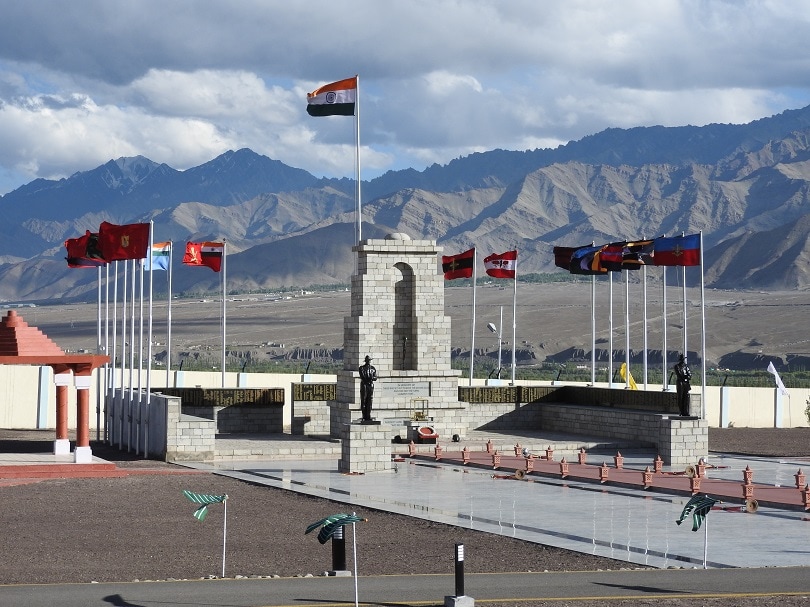
As you enter Leh, you will see a dome-shaped building on your right side. Make a stop, park your vehicle and go inside. Hall of Fame is a museum with weapons and history exhibits on display. They portray the exemplary courage and bravery our soldiers have shown in the Indo-Pak wars over decades. You can also buy souvenirs from here and watch a short documentary on past wars and military operations conducted by our army forces.
- Opening and Closing time:
Mornings – from 9 AM to 1 PM
Evenings – from 2 PM to 7 PM
- Entry: Rs. 25 per person
Magnetic Hill
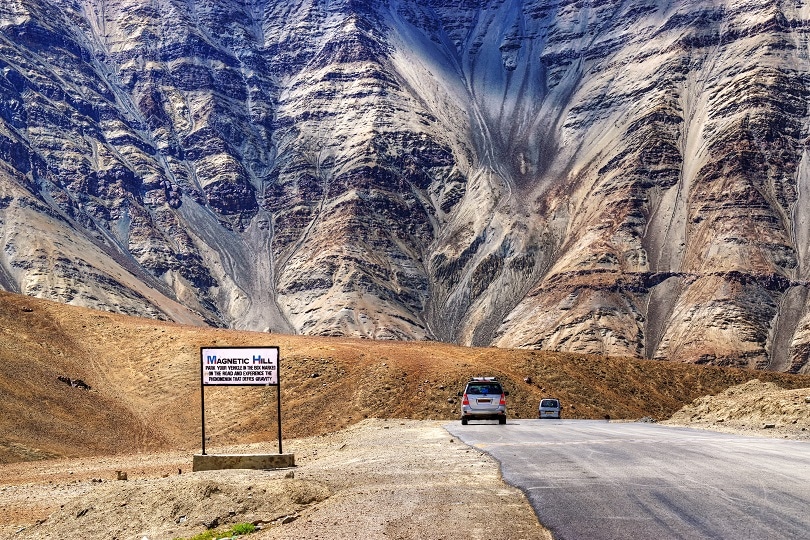
Just 30 kilometres away from Leh, on the Leh-Kargil Highway, Magnetic Hill is a wonder in itself. It is said that it has metallic properties which pull the car uphill when it is not in motion. There have been many pieces of research on this stretch of road, and some people say that it is just an optical illusion. So, you need to go and see for yourself whether it is an illusion or a magical spot.
- Best time to visit: From July to September because roads are clear and the weather is nice.
Leh Palace
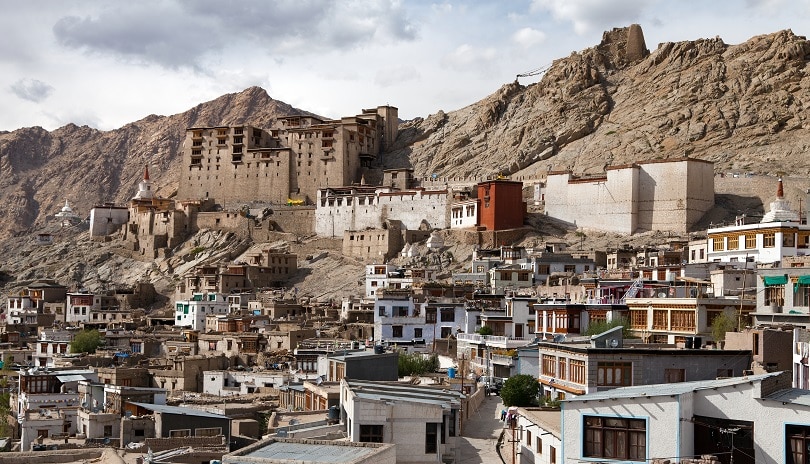
The Leh Palace, also called the Namgial palace, is the town’s most prized possession. Constructed in 1553, the castle is now in ruins, but it still shines on the Tsemo hilltop. Right on the edge of the palace, you can get the best view of Leh. There is also an exquisite collection of jewellery and artefacts that are more than 450 years old. It also stores many rare stones.
- Opening and Closing Timing: All days of the week, 7:00 AM to 4:00 PM.
- Entry: Indians – Rs. 15 per person, Foreign Nationals – Rs. 100 per person
Shanti Stupa
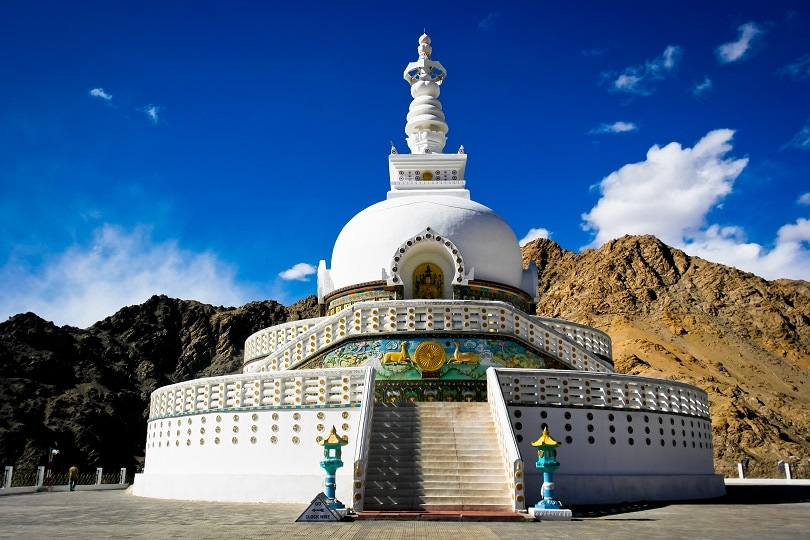
Shanti Stupa a white-domed Tibetan structure built by the followers of Buddhism. At the height of 11,841 feet above sea level and with Leh Palace situated towards its front face, the views from this point are beautiful. Overlooking the vibrant Leh city, the Stupa looks exceptional at night as the moonlight casts its reflection on the dome. It promotes world peace and has a huge Buddha idol at the base. You can lounge at the cafe right below the Stupa. When the lights of the Stupa light up, the view will surely take your breath away!
- Opening and Closing Timing: All days of the week, 5:00 AM – 9:00 PM
Hemis Monastery
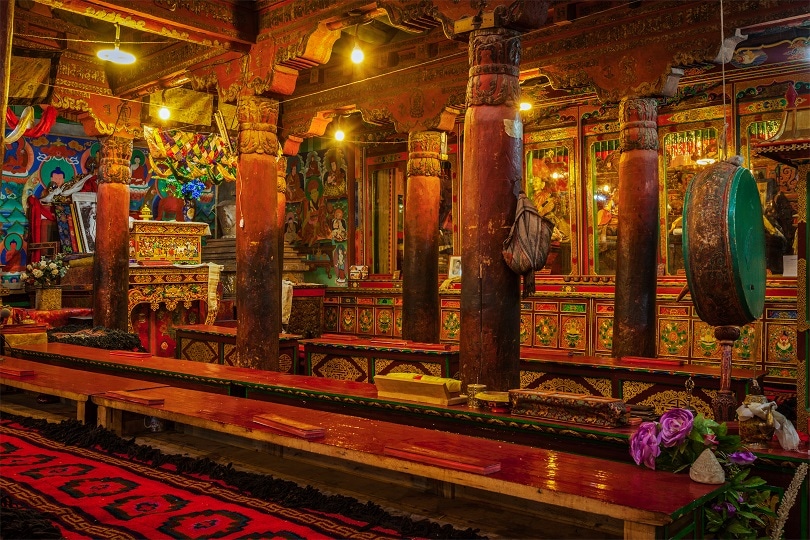
Considered as the largest monastery in Ladakh, the 300-year-old Hemis monastery is a delight in itself, not only because of its architecture and the annual Hemis festival but also because of its surroundings. The monastery shares its boundary with the Hemis High Altitude National Park surrounded by yellow mustard fields and a Tibetan restaurant right outside it. Must-try! Because it serves mouth-watering food. The Hemis monastery is a good recommendation.
- Opening and Closing Time: All days of the week, 5:00 AM – 9:00 PM
Thiksey Monastery
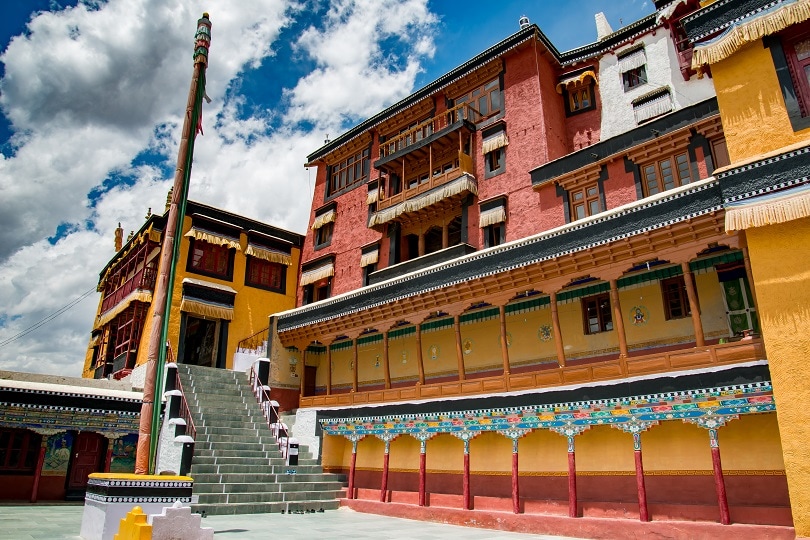
The Thiksey gompa is considered to be the largest gompa in central Ladakh. It is located 19 kilometres away from the main city and sits upon a hill with a view to die for. The fascinating fact about Thiksey is that it holds the most massive statue of the Maitreya Buddha in Ladakh within its buildings. The walls of the monastery are painted in yellow, red, white and black that makes it look similar to that of Lamayuru, a monastery on the way from Kargil to Leh. This site should not be missed if you’re in Leh.
- Opening and Closing Timings: All days of the week, 7:00 AM – 7:00 PM
- Entry: The ticket costs Rs. 20 per person
Shey Palace
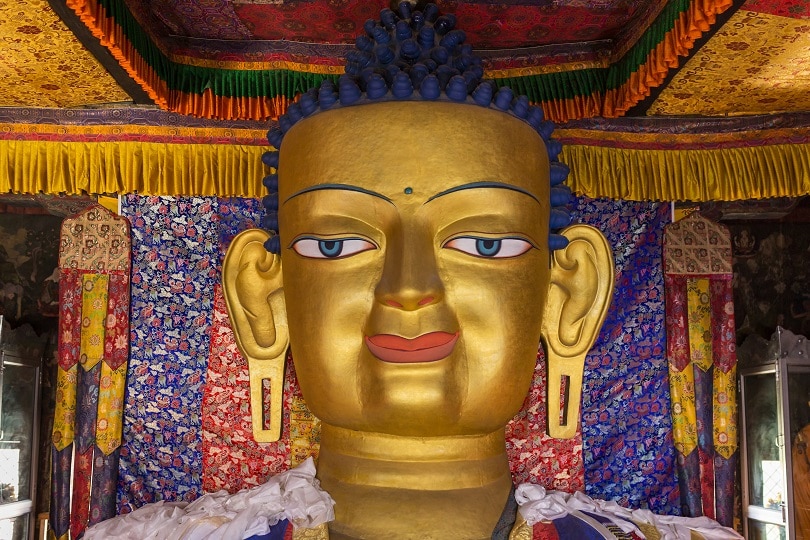
The Shey Palace looks rugged and old on the outside, almost in shambles but the beauty of the palace lies inside it. To reach the entrance, you will have to climb uphill for less than a kilometre but the walk is worth it. The main prayer hall of the palace comes first and its stairways can look like a maze. The interiors of the palace are beautiful, carved with wood and covered with painting and inscriptions of the Buddha on the walls, the locals often come here to offer their prayers. A little walk behind the prayer hall will take you to the Stupa and the statue of Maitreya Buddha, also not to forget the amazing view one gets to see.
- Opening and Closing Timings: All days of the week, 7:00 AM – 8:00 PM
Chamba Temple
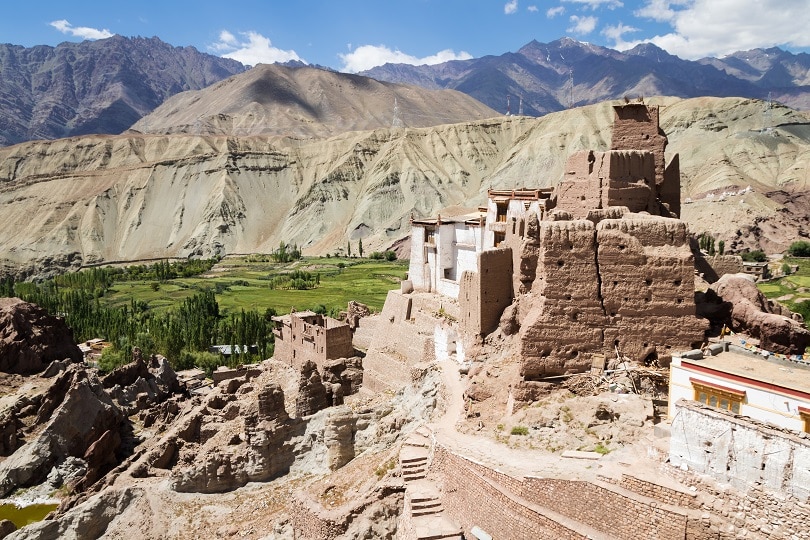
The Chamba temple in Leh falls on the way to the Leh Palace. This 15th-century temple within the Leh city is dedicated to Maitreya Buddha and stores various manuscripts and paintings devoted to Buddha. Although easily reachable, this temple is still a lesser-known site. This temple is part of the Basgo Monastery.
- Opening and Closing Timings: Vary
Sindhu Ghat
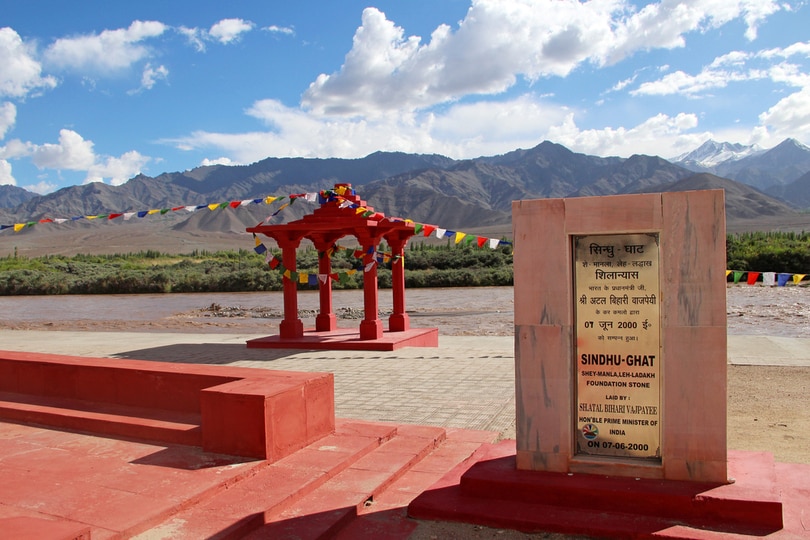
The Sindhu ghat is a small place where people go to soak their feet in the ice-cold Indus River. You can easily park your vehicle there and sit comfortably on the ghat. Washing cars/clothes/motorbikes/cattle are discouraged to keep the ghat clean and fresh. This riverbank is located close to the Shey village in Leh and hosts many cultural events to encourage communal harmony.
- Open all the time.
Sankar Monastery
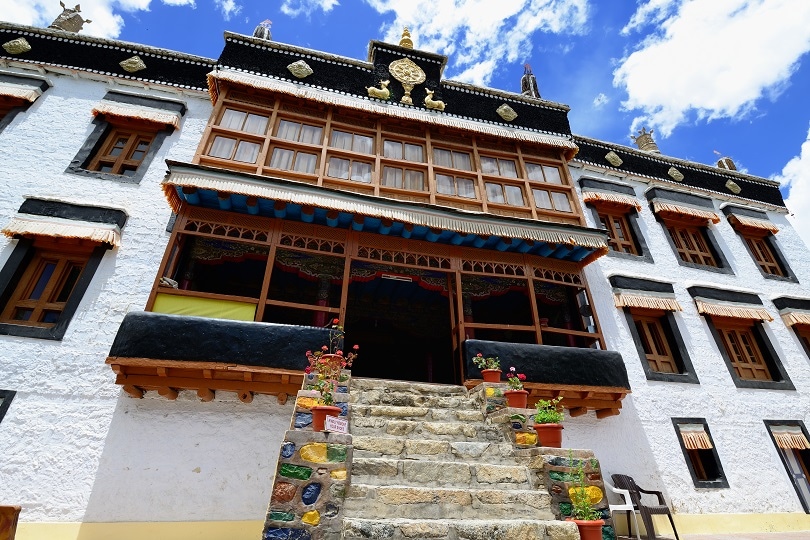
Just a half an hour walk from the Leh town breathing fresh air and you will reach the Sankar monastery. It is the daughter gompa of Spituk. The walls of this monastery are painted with exquisite images and figures. The monastery is also home to the statue of Avalokiteśvara which has 1000 heads and 1000 arms. The head lama walks up to the monastery on the hill and lights butter-lamps every morning!
- Opening and Closing Timings: Mornings – 7.00 AM to 10.00 AM and Evenings – 5.00 PM to 7.00 PM.
Stok Palace
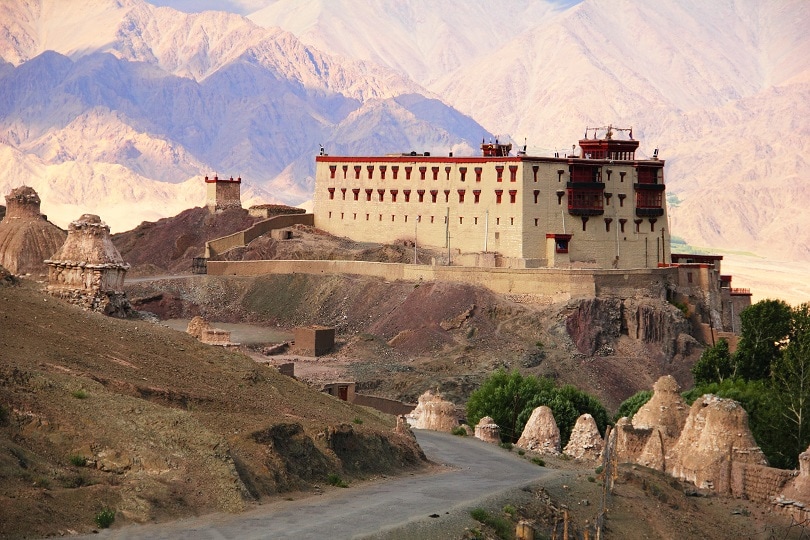
The Stok Palace has an era of Tibetan history behind it. The palace is the residence of the erstwhile prince. At a distance of 17 kilometres from the Leh city, it has been constructed in a blend of traditional and contemporary architectural styles using stones. It houses a museum with several artefacts, relics, royal seals, regal costumes, coins and armoury on display. You can go through the collection of religious teachings by Lord Buddha in the library. The most interesting part is the café which offers an open terrace seating with fabulous views. Perks – photography is allowed!
- Opening and Closing Timings: All days of the week, 8:00 AM – 5:00 PM
- Entry: Rs. 50 for adults
Leh Bazaar
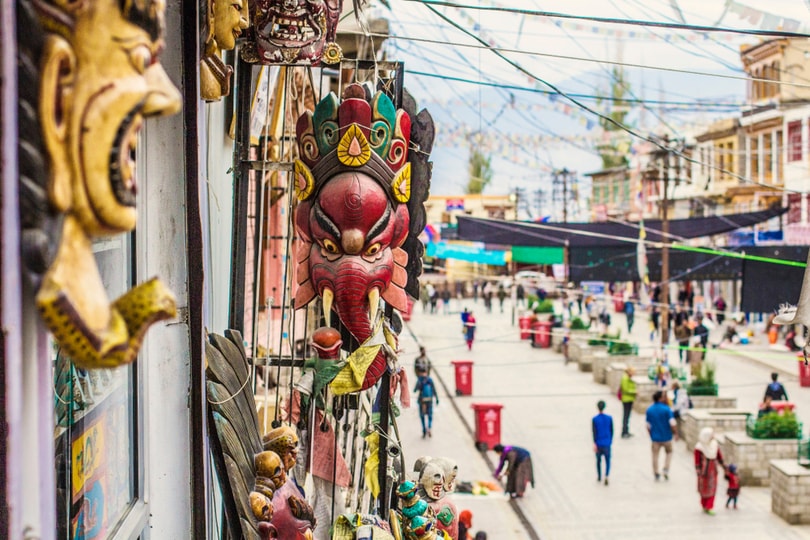
The Leh Bazaar has some very interesting shops and sells almost everything! From bags to vegetables, the Leh market is full of unique pieces. You will find a Tibetan Refugee Market on every corner that would be selling a variety of jewellery and artefacts. The perfect place to go mad shopping! There are also many good restaurants around. Some of them are Gesmo, The German Bakery (be careful which one is authentic, every restaurant claims to be German), Tibetan Kitchen and many more you will have to explore on your own. The food is quite affordable in most of the restaurants unless you decide to walk in a fancy one.
- Opening and Closing Timings: 6 AM – 10:30 PM, all days
Leh Heritage Walk
The Leh heritage walk takes you around all the heritage sites in Leh. Also covering the ones that are usually ignored or not mentioned in most of the travel itineraries and searches. This walk provides an offbeat travel experience and gives you a taste of the real local culture as you go on exploring from one site from another.
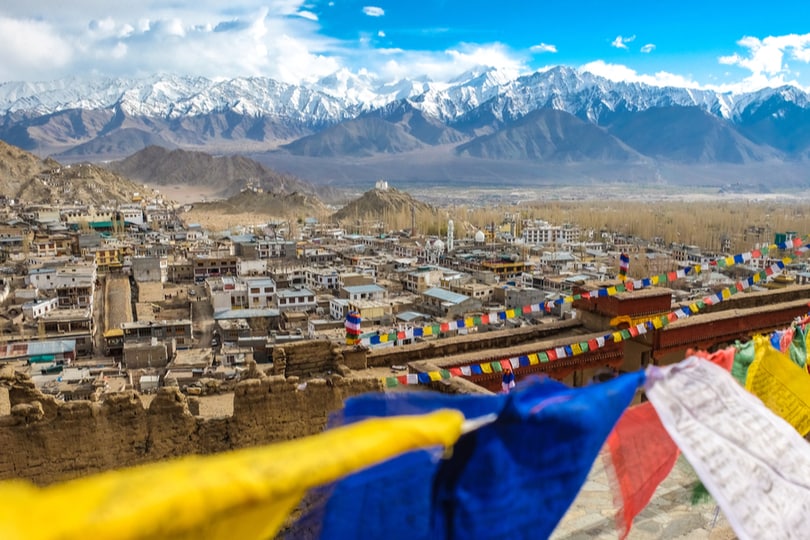
PLACES TO SEE AROUND LEH
This guide includes things to see in and around Leh, at nearby places like Nimoo, Nubra Valley, Khardung-La, Pangong-tso, Tso-moriri, Lamayuru and others. The best way to travel around is to have your private vehicle or hire one locally. Remember to obtain inner line permits.
Pathar Saheb Gurudwara
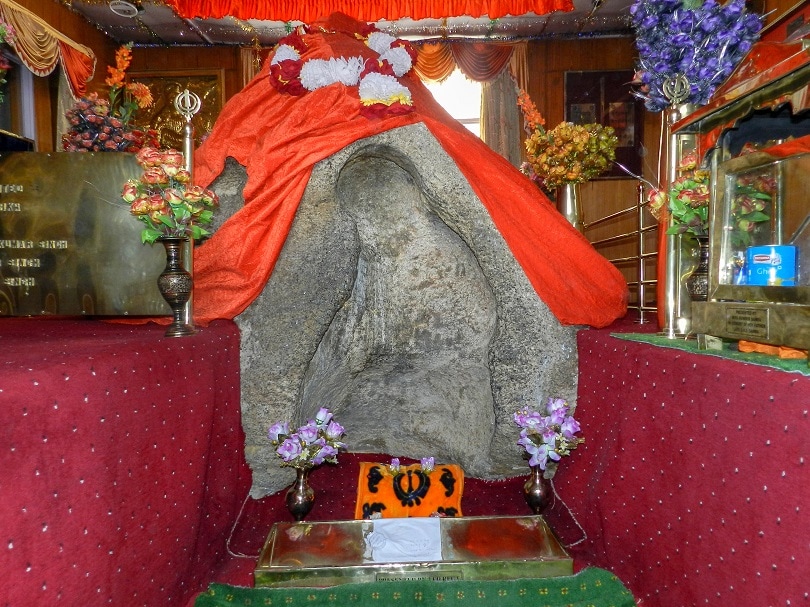
The Pathar Saheb Gurudwara is en route Kargil to Leh and attracts many tourists who stop by to seek blessings of Guru Nanak, to whom this site is dedicated. The Indian Army maintains the Gurudwara and every year many dignitaries and soldiers come to pay offerings here. When you stop there, you would be offered tea and snacks to have a comfortable journey ahead.
- Opening and Closing Timings: All days of the week, 6:00 AM – 7:00 PM
Sangam- The Confluence of Indus and Zanskar River
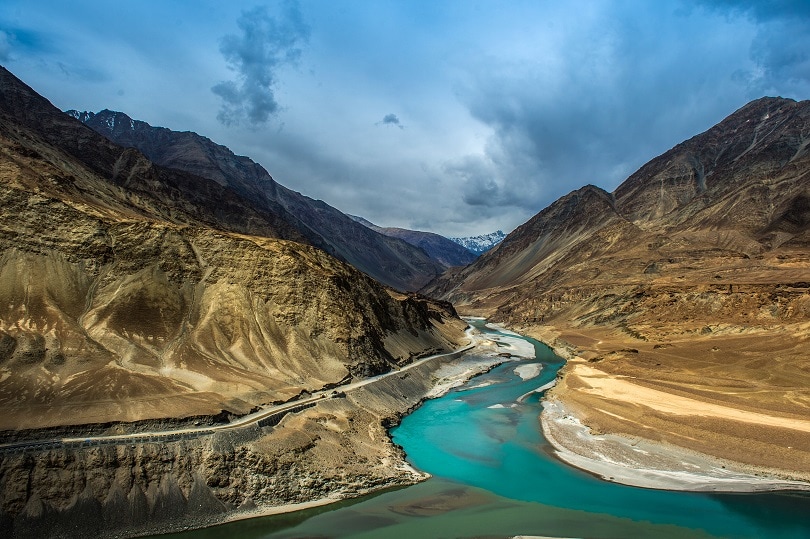
Sangam is the point where the Indus and Zanskar rivers merge. You can view it while you are on the Leh-Kargil highway. A lot of adventure activities like white water river are carried out here. Many river rafting and water sports expeditions begin from this point and go further through the river’s length.
- Best views are in the daytime.
Pangong-Tso
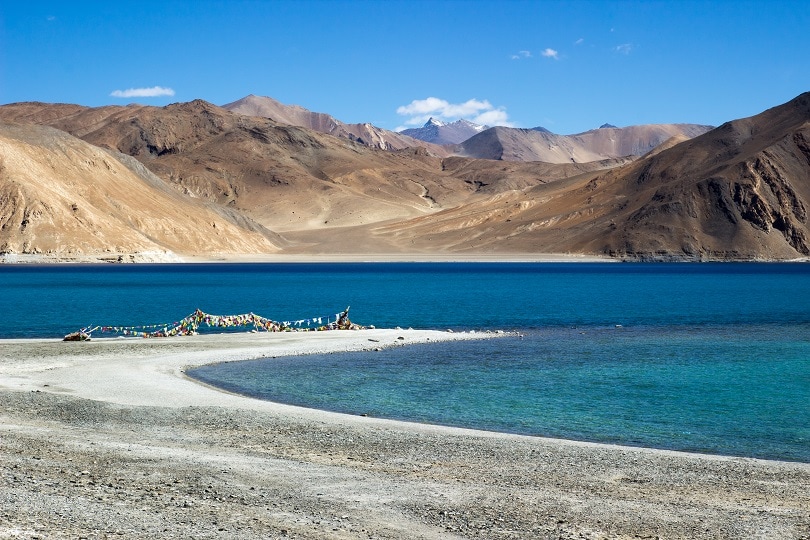
The Pangong Lake can be reached after crossing the Chang-La pass which is the 3rd highest pass in Ladakh and then crossing Tangste. The Pangong Lake is known for its blue waters and changing hues throughout the day. Another fascinating fact about this Lake is that 60% of its waters are under China. To go to this Lake, one needs to get an inner line permit that can be obtained from the local DC office. Pangong is a 5-hour drive from Leh.
- Opening and Closing Timings: All days of the week, 8:00 AM – 5:00 PM.
Tso-Moriri Lake
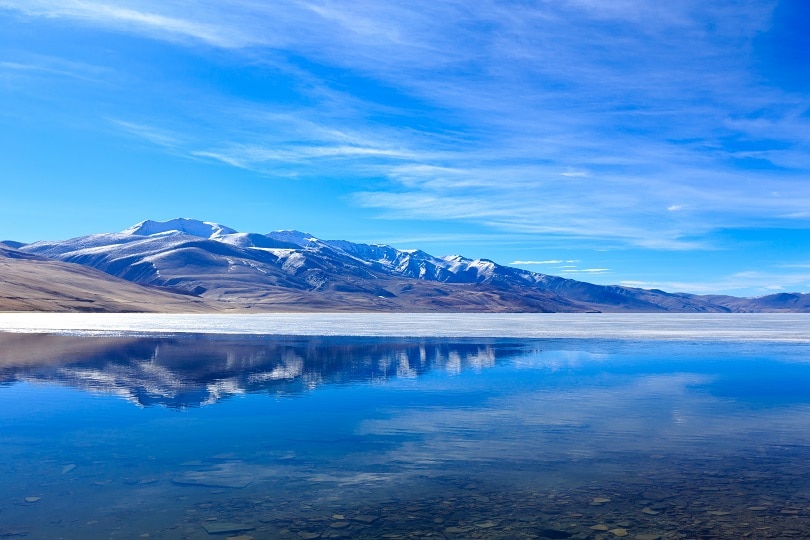
Tso-Moriri Lake in the Changtang region can be reached through the Manali-Leh highway via Tso Kar. The lake is 240 kilometres away from Leh and requires an inner line permit. Tso-Moriri is given more importance because the entire Lake comes under the Indian Territory and has much more flora and fauna as compared to Pangong. This lake is also the highest altitude lake in the trans-Himalayan bio-geographic region.
- The best time to visit Tso Moriri is from May to September
Nubra Valley
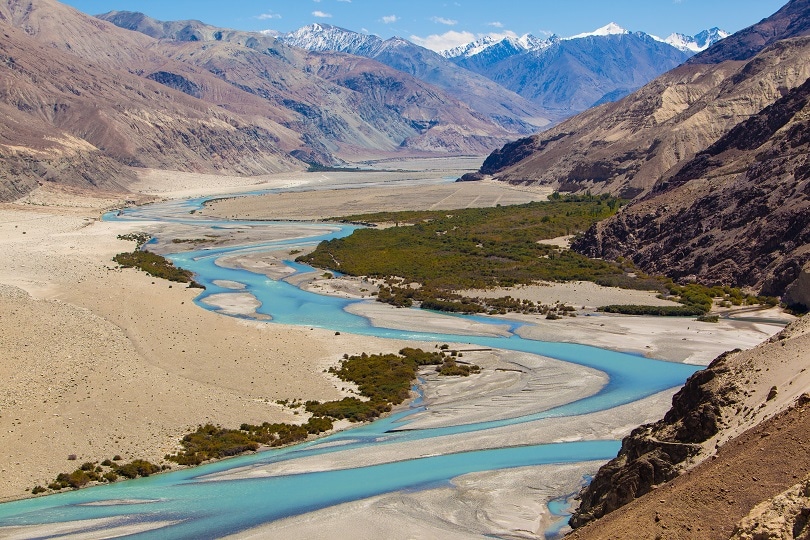
The Nubra Valley comes after crossing the famous Khardung-La at 18,380 ft above sea level and is famous for its dunes and double hump camels. The administrative capital of Nubra is Diskit which has the Diskit monastery with a 106 ft tall statue of Maitreya Buddha, the largest in Ladakh. The Siachen range is also visible from the Nubra valley. An inner line permit is required at North Pullu after Khardung-La to enter the Nubra valley.
- Best time to visit the Nubra Valley is from September to October as Khardung La often closes down October onwards due to excessive snowfall or rains.
Lamayuru Monastery
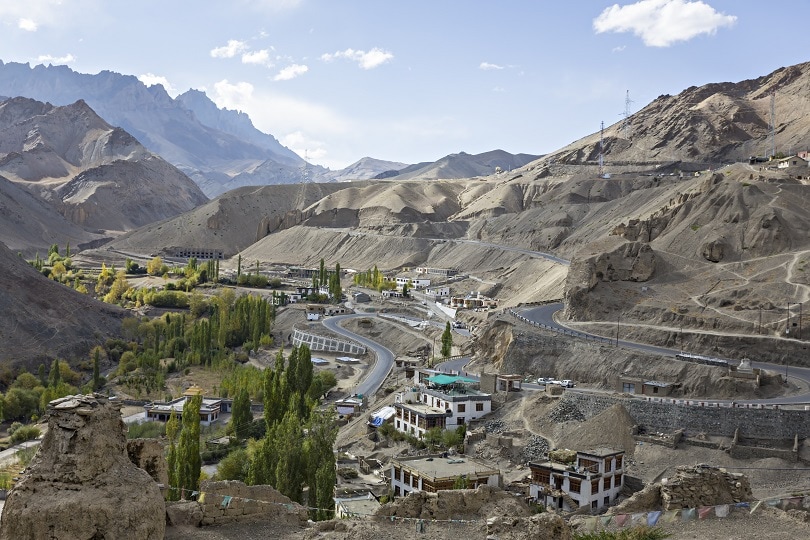
Dating back to the 11th century, Lamayuru is all for peace. A monastery located on the Kargil-Leh highway, it is one of the oldest monasteries in Ladakh and a retreat for those who do not mind being cut-off from the world. Located 127 kilometres from the Leh town, it is home to more than 150 monks. A rich collection of artefacts, wall paintings, thangkas, statues and carpets make this place even more interesting. Situated amidst badlands in the remote area, the surrounding landscape of this site is strikingly similar to that of the moon.
You can miss anything and everything in Ladakh but not this lovely monastery!
- It is recommended to visit between June to September.
Alchi
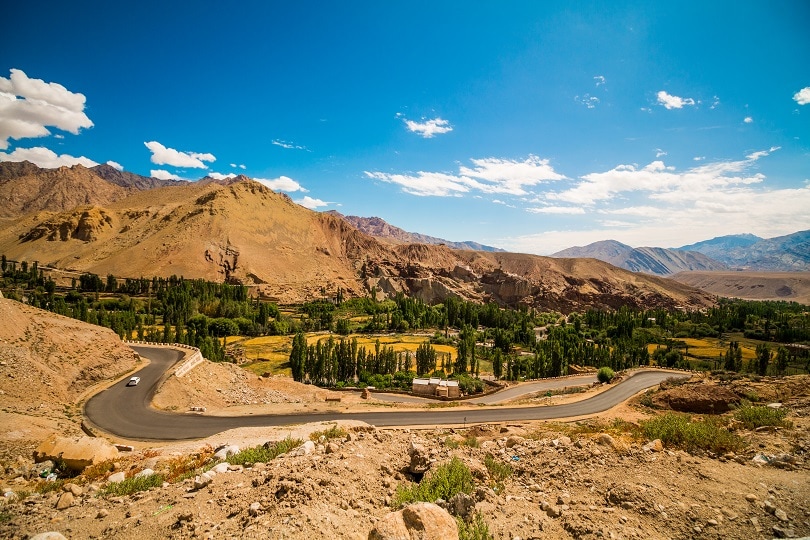
Another monastery located slightly off the road from the Kargil-Leh highway. The Alchi monastery is pretty and serene. A market surrounds the entrance of the monastery. The market is lined with shops that sell various types of gems, prayer flags, prayer wheels and other Tibetan items. A must visit for its spectacular beauty!
- Opening and Closing Timings: All days of the week, 8:00 AM – 6:00 PM (Lunch: 1:00 PM – 2:00 PM)
- Entry: Indians – Rs. 25 and Foreign Nationals – Rs. 50
Phyang

A village just 15 km west from Leh, Phyang is famous for its monasteries and the 900 yr old museum that stores ancient gems and jewels from Kashmir, China and Tibet. The beautiful landscape makes the monastery look like a paradise. The sight of red-robed lamas chanting makes this place full of positive vibrations. The Gang-Sngon Tsedup festival is Phyang’s annual festival which is celebrated from the 17th day to 19th day of the first month of the Tibetan calendar. Sacred dances are performed on the 2nd, 3rd and the 6th day of the festival.
- It is best to plan a trip in July or August because these are the months when the Phyang Tsedup Festival is celebrated in the Phyang Monastery in Ladakh.
At Leh-Ladakh, you will see the Great Himalayas up close. From monasteries to picturesque views, your time here will be spent in tranquillity. The places to visit in Leh Ladakh are many and each one offers a different experience. So keep this travel guide handy when you travel to this destination that promises memories of a lifetime.
- Top 16 Things to do in Kolkata in 24-hours - July 25, 2019
- Savour These Delicacies While in Bali for a True Gastronomical Treat! - May 29, 2019
- A Seasonal Guide to Sri Lanka – The Pearl of the Indian Ocean 2019 & 2020 - May 24, 2019
- Six Experiences You Mustn’t Miss in Sri Lanka for A Fabulous Trip! - May 24, 2019
- 5 Bazaar Ramadan terbaik di Kuala Lumpur. - May 15, 2019
- Planning to Visit Ladakh? Here is a Seasonal Guide to Help You Plan Your Trip - May 8, 2019
- Visit These Places in Bali For an Exciting Vacation in The Tropical Island! - May 7, 2019
- 8 Best Places to Spend Your Vacation in the Hills of Himachal Pradesh - April 17, 2019
- Places to Visit in Thailand - April 16, 2019
- Want to Visit Bali at Minimum Cost? Follow Our Guide to Travel Bali on a Budget! - April 12, 2019

